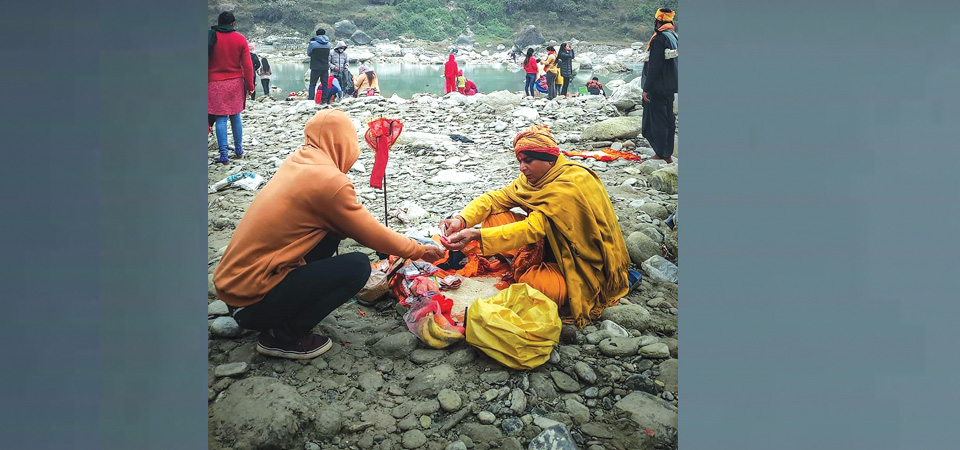Maghe Sankranti Festival

Benazir Ahmed Siddique
A festive atmosphere is created in the morning along the banks of the river Kali Gandaki in Devghat near Tanahun, a hilly district of Nepal. Ignoring the cold wind, many go out to take part in the Maghe Sankranti festival.
Winter Time
Wrapped in winter clothes and treading the rocky path, the devotees gather at the bank of the river with fruits, flowers, leaves, various grasses, grains, etc. for worship. At the end of the worship, all items they carry along are offered in the sacred river.
Sadhus and priests are seen sitting on the bank of the river. Devotees give money, rice, pulses, vegetables, fruits to these sadhus and priests. Some sit with holy scriptures, some hold sacred threads and recite mantras. Some tie these threads to hands, necks and certain trees. Many vendors are seen selling flutes, food items, clothes and children's toys. This beautiful festival is known as Maghe Sankranti in Nepal.
Nepal is a country that is rich in language, culture, history, heritage, nature, different castes, religions and festivals. Maintaining the trend of diversity, the people of Nepal organise more than 22 big festivals in a year. The main festival in mid-January is Sankranti that falls in the Nepali month of Magh. Members of Nepal's Tharu community celebrate this special day as their New Year day. They call it Maghi.
The government has declared Maghe Sankranti as the main annual festival for the Magar community. Apart from this, Maghe Sankranti is celebrated in different communities of Nepal like many other traditional religious festivals.
Scientifically, winter in the Northern Hemisphere now occurs between December 21 and 22 January. However, the winter season gradually changes due to the axial progress of the earth and every 800 years the arrival of winter occurs one day ahead. Maghe Sankranti is a special day when the sun is believed to reach farthest in the southern hemisphere and start moving north. Therefore, according to legend, Magh is considered to be the rebirth of life in the northern parts of the globe.
In the mountains of Nepal, it was once believed that when people went to fields during the Maghe Sankranti, all the weeds would automatically become crops due to the generosity of nature.
Like other festivities in Nepal, Maghe Sankranti has its legend. It tells us that there was a merchant in the town of Bhadgaon who noticed that his sesame supply had not diminished, even though his whole business had grown considerably. When he searched the matter thoroughly, he found an idol of Lord Vishnu hidden under the sesame seeds. Since then the Idol of Til Madhav was worshipped on this day and it is believed that through this worship the food and wealth of the Bhadgaon community will increase.
In Nepal, it is believed that those who die on this day of Magh, he/will go to heaven and escape the torments of hell. Therefore, Maghe Sankranti is a very important religious occasion in Nepal.
Social Harmony
The winter solstice is the beginning of the month of Magh, usually in the middle of January. This day marks the end of the month of Poush. This day is considered the most important day for holy bathing. In this religious ceremony, everyone usually takes holy dips at many sacred rivers of the country. The banks of the holy Bagmati River, which flows past Patan in Nepal, are considered to be the holiest sites for this purpose. In recent years, the number of people taking part in holy baths has decreased due to pollution of river water. However, people still go to the river very early in the morning just to soak themselves with water. Apart from this, they also go to Rato Machhendranath and Agimati temples to pay homage to various deities.
On the day, after taking a holy bath and worshipping at the temple, the people of Nepal eat til ko (sesame seed) laddu, chaku (Newari cuisine made from concentrated sugarcane juice, jaggery, ghee, and nuts). All the members of the family get together, put on new clothes, go to the Maghe Sankranti fair and share the joys among themselves through food and gossip. The married daughters and their spouses visit the parents' house to seek blessings. Therefore, this festival plays a very good role in maintaining family ties and social harmony.
(The author is a pharmacist, writer and social activist)
Recent News

Do not make expressions casting dout on election: EC
14 Apr, 2022
CM Bhatta says may New Year 2079 BS inspire positive thinking
14 Apr, 2022
Three new cases, 44 recoveries in 24 hours
14 Apr, 2022
689 climbers of 84 teams so far acquire permits for climbing various peaks this spring season
14 Apr, 2022
How the rising cost of living crisis is impacting Nepal
14 Apr, 2022
US military confirms an interstellar meteor collided with Earth
14 Apr, 2022
Valneva Covid vaccine approved for use in UK
14 Apr, 2022
Chair Prachanda highlights need of unity among Maoist, Communist forces
14 Apr, 2022
Ranbir Kapoor and Alia Bhatt: Bollywood toasts star couple on wedding
14 Apr, 2022
President Bhandari confers decorations (Photo Feature)
14 Apr, 2022











